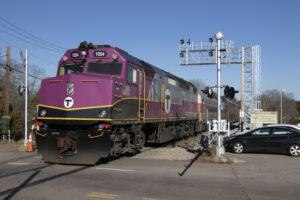BOSTON — Significant cuts to commuter rail service — including an end to service after 9 p.m. and on weekends — are part of plans announced Monday by the Massachusetts Bay Transportation Authority to address budget shortfalls resulting from the COVID-19 pandemic.

Some peak and off-peak service would also be eliminated, cutting weekday trains from a pre-pandemic level of 505 per day to 430. Six stations with low ridership would be closed; Boston.com reports those stations are Plimptonville (Franklin Line), Prides Crossing (Rockport Line), Silver Hill and Hastings (Fitchburg Line), Plymouth (Plymouth Line), and Cedar Park (Haverhill Line). Less than 50 riders total were using those stations, according to the MBTA’s chief of operations.
The one exception to the end of weekend service will be on the Fairmount Line, where buses will replace trains.
Subway and trolley service will also see cuts, closing one hour earlier (at midnight rather than 1 a.m.) with frequency reduced by 20% during peak and non-peak periods. The Green Line E Branch will terminate at Brigham Circle, with existing bus service covering the remainder of the route.
The cuts — which also will include the elimination of all ferry routes and 25 bus routes — attempt to reflect current levels of ridership and transit dependency for riders. Commuter-train ridership is about 13% of pre-pandemic levels and just 8.5% during morning peak periods, while subway and trolley ridership is about 24% of pre-COVID levels. Buses are carrying about 41% of pre-pandemic ridership.
In a letter to riders published on the MBTA website, general manager Steve Poftak explains the cuts, writing, “Using limited resources to operate nearly empty trains, ferries and buses is not a responsible use of the funding provided by riders, communities, and taxpayers, and it does not help support the transportation needs of our region. Saving resources now will help the MBTA to bring back service when it is needed after the pandemic has faded.” He also notes that these proposals are not finalized — details on the plans, and how to respond to them, are available here — and that they are not permanent. “The MBTA will also periodically realign service to match current and future ridership patterns, when durable revenue is available to pay for such service,” he writes.









